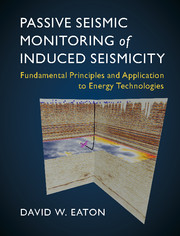 Passive Seismic Monitoring of Induced Seismicity
Passive Seismic Monitoring of Induced Seismicity Book contents
- Frontmatter
- Contents
- Preface
- List of Symbols
- Part I Fundamentals of Passive Seismic Monitoring
- Part II Applications of Passive Seismic Monitoring
- 5 Passive-Seismic Data Acquisition
- 6 Downhole Microseismic Processing
- 7 Surface and Shallow-Array Microseismic Processing
- 8 Microseismic Interpretation
- 9 Induced Seismicity
- Appendix A Glossary
- Appendix B Signal-Processing Essentials
- Appendix C Data Formats
- References
- Index
8 - Microseismic Interpretation
from Part II - Applications of Passive Seismic Monitoring
Published online by Cambridge University Press: 07 June 2018
- Frontmatter
- Contents
- Preface
- List of Symbols
- Part I Fundamentals of Passive Seismic Monitoring
- Part II Applications of Passive Seismic Monitoring
- 5 Passive-Seismic Data Acquisition
- 6 Downhole Microseismic Processing
- 7 Surface and Shallow-Array Microseismic Processing
- 8 Microseismic Interpretation
- 9 Induced Seismicity
- Appendix A Glossary
- Appendix B Signal-Processing Essentials
- Appendix C Data Formats
- References
- Index
Summary
Take care of the sense and the sounds will take care of themselves.
Lewis Carroll (Alice's Adventures in Wonderland, 1865)Interpretation is the science of finding meaning in data. The primary purpose of microseismic monitoring is to develop insights into the nature and extent of brittle deformation processes in the subsurface. Passive-seismic monitoring has many applications, including monitoring of fluid stimulation for enhanced geothermal systems and mine-safety protocols. The main focus of this chapter is passive seismic monitoring of MW < 0 induced microseismicity associated with hydraulic fracturing, although the interpretation workflow is more broadly applicable and could be used, for example, in passive seismic monitoring of geothermal stimulation programs. Interpretation of passive-seismic data for induced seismicity, considered here as events with MW ≥ 0, is the subject of the next chapter. In the case of hydraulic-fracture monitoring, microseismic data are generally acquired for the following purposes:
• surveillance of the growth of fracture networks;
• estimation of the spatial extent of the stimulated region within the reservoir;
• characterization of the complexity of induced fracture networks;
• diagnosing potential operational issues during well completion.
There is considerable research potential for development of more advanced microseismic interpretation methods, such as quantifying the state of stress, imaging discrete fracture networks, time-lapse studies, understanding possible slow-slip processes and reservoir characterization, including facies analysis.
In this chapter, a systematic approach to microseismic interpretation is introduced. This approach is guided by an underlying philosophy that the interpretation of any experimental data should be repeatable, observation-driven and, to the greatest extent possible, quantitative. As part of this approach, applicable uncertainties in measured quantities should be reported, along with metadata describing how reported uncertainties were obtained. The proposed interpretation procedure is built upon four key concepts:
Attributes, following Taner (2001), are physical characteristics derived from observations, either by direct measurements or by logical or experience-based reasoning. There are two fundamentally different types of attributes: measured and inferred (indirect). Examples of measured attributes are the length of a microseismic cluster and the dimensions of the estimated stimulated volume (ESV); examples of inferred attributes are fracture length and SRV.
- Type
- Chapter
- Information
- Passive Seismic Monitoring of Induced SeismicityFundamental Principles and Application to Energy Technologies, pp. 209 - 240Publisher: Cambridge University PressPrint publication year: 2018


